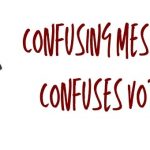Who are you to voters? At the start of an election campaign, political candidates outline their positions on various issues. These are called candidate statements, and they are used to help voters make informed choices. In this article, we will explore what a memorable candidate statement is and the key elements you need to write one.
Let’s start with the most obvious question:
What is a candidate statement?
A candidate statement is an outline of a political candidate’s qualifications. It summarizes their positions on key issues, and their plans for the future. It’s more like a stump speech, as a statement is designed to be straight to the point, and connect with voters on a personal level.
Think of it as a voter introduction.
Versions of this information may be eventually reworked and included in voter information guides, campaign websites, and brochure material.

Writing a candidate statement isn’t as hard as you think.
Elements of a Candidate Statement
When writing a candidate statement, the final result should easily provide voters with an understanding of the candidate’s background, platform, and vision. Just like a candidate’s personal bio, your statement should be concise and highlight your unique skills and values.
An effective candidate statement should include the following elements:
Introduce yourself and provide your background
Your introduction should be concise and clear. It should outline who you are and what office you are running for. Then go into a short background description, while highlighting your unique qualifications for the elected position.
For example, you can mention how growing up in the local area gives you a unique perspective on how you can help improve the lives of residents today.
For example, you could say something like. “I was fortunate to have grown up in our vibrant community. It’s this very upbringing that instilled in me the values and understanding that make me qualified for mayor. My roots in this area have given me insight into the challenges we face, as well as the opportunities that lie ahead.”
Lean in on your experience and skills
The background section should be all about your education, work experience, and other relevant accomplishments. Provide context so voters can better understand how your experience and skills directly relate to the position you seek.
For example, suppose you are running for sheriff of a county, and an important election issue is that of community policing. You have a law enforcement background and worked as a community outreach officer. This makes you well-qualified to address the issue. So, when drafting your candidate statement, you might highlight your specific qualifications, such as:
- Graduated with honors from a police academy.
- Served as a community outreach officer and earned a trusted reputation acting as a liaison between the community and law enforcement.
- Led successful initiatives that focused on officer training and building relationships with community leaders.
By focusing on these qualifications, you’ll show voters that you have the experience and skills to handle the role of community policing.
Describe the issues and your platform
This section is perhaps the most important, as it is where you outline your positions on the issues. Highlight the most pressing issues that your voters are facing. Break down your platform into a concise, informed, and well-organized summary. For each issue, provide details on policy solutions or initiatives that you plan to implement if elected.
Wrap it up with a call to action
Finally, finish up with a summary of your main points. And don’t forget to add a clear call to action. Typically, this will be a request for your audience to support the campaign, to donate, volunteer, or get involved in some other way. Deliver your conclusion with confidence and conviction, so you leave a strong impression on the audience.
“Our community is at a crossroads. We have challenges, but also opportunities. We have to work together to make a difference. To do that, I need your support this November. Only then can we shape a better future for our city.”
Preparing for your audience
Before you start writing your statement, you’ll need to do some research and preparation. Here are key elements of this process:
- Research: Before writing a candidate statement, it’s important to research the issues and concerns that are most important to the electorate or audience. This can involve focus groups, researching polling data, and finding out more about your opponent’s stances.
- Writing: Once the research is complete, you or your team will begin the writing process. Again, what you say should be concise and easy to understand. It should include a clear message that reflects your vision for the future. You will end up creating several versions, as your material should be tailored to each specific audience you present to. This may determine whether you mention specific endorsements or organizations that you belong to.
- Editing: Once the writing is done, it’s time to edit and refine the material. This may involve cutting out unnecessary information, adding additional detail, or rephrasing certain sections for clarity or impact. Carefully review your text to ensure that it is free of errors. Make sure that it effectively communicates your message.
- Rehearsal: After your statement is written, it’s time to rehearse the speech. You should do it enough so you are comfortable delivering it in a public forum. You may want to practice in front of a mirror, record yourself on video, or deliver your speech to a few trusted supporters or advisors for feedback. The more you practice, the more comfortable you’ll be speaking before an audience.
Conclusion
Overall, a well-crafted candidate statement can make a big difference in your political campaign. It can help establish credibility and build support for your election.
Recommended Reading: Political Candidate Profile and Biography Worksheet [PDF]
« How to Build a Winning Political Campaign TeamWill Your Social Media Past Hurt Your Political Future? »
Tags: personal branding








